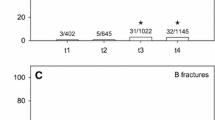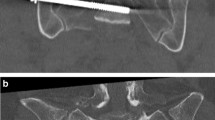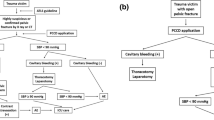Abstract
Background:
Since the Academic Medical Center Amsterdam was appointed as a level-1 trauma center in July 1997, the number of polytrauma patients who were presented has increased. This stimulated us to perform a retrospective analysis on the treatment results of patients with a pelvic ring fracture and to evaluate our treatment strategies.
Materials and Methods:
A chart review of all patients with a partially stable fracture (Tile/AO type B) or an unstable fracture (Tile/AO type C) was performed. All patients presented between 1 January 1990 and 31 December 2001 were included. Two historical groups (1990–1997 and 1998–2001) were formed. General demographics, treatment method, complications, re-operations, length of hospital stay and anatomic results were recorded for all patients.
Results:
Fifty-two patients were included in group 1 and 65 patients in group 2. There was a lower mortality in group 2. The B-fractures were treated either conservatively (group 1 83.3% vs. group 2 73.8%), by external fixation (16.7 vs. 9.5%) or by ORIF (0 vs. 16.7%). C-fractures were treated by ORIF in 32.1 versus 82.6%, by external fixation in 28.6 versus 4.4% and conservatively 39.3 versus 13.0%, respectively. Fracture healing with less than 10 mm displacement was achieved in 58.3 versus 78.6% for the B-fractures, while this was achieved in 42.9 versus 73.9% in the C-fractures. Group 2 showed significantly fewer complications.
Conclusion:
Evaluating two consecutive patient groups shows an increase in the number of fractures. A more aggressive surgical treatment has lead to lower mortality, improved anatomical reduction, and lower rate of complications.
Similar content being viewed by others
References
Pohlemann T, Gansslen A, Schellwald O, Culemann U, et al. Outcome evaluation after unstable injuries of the pelvic ring. Unfallchirurg 1996;99:249–59.
Ragnarsson B, Jacobsson B. Epidemiology of pelvic fractures in a Swedish county. Acta Orthop Scand 1992;63:297–300.
Burkhardt M, Culemann U, Seekamp A, Pohlemann T. Strategies for surgical treatment of multiple trauma including pelvic fracture. Review of the literature. Unfallchirurg 2005;108:812,814–20.
Pohlemann T, Tscherne H, Baumgartel F, Egbers HJ, et al. Pelvic fractures: epidemiology, therapy and long-term outcome. Overview of the multicenter study of the Pelvis Study Group. Unfallchirurg 1996;99:160–7.
Shuler TE, Boone DC, Gruen GS, Peitzman AB. Percutaneous iliosacral screw fixation: early treatment for unstable posterior pelvic ring disruptions. J Trauma 1995;38:453–8.
Pohlemann T, Gansslen A, Schellwald O, Culemann U, et al. Outcome after pelvic ring injuries. Injury 1996;27:B31–8.
Majeed SA. External fixation of the injured pelvis. The functional outcome. J Bone Joint Surg Br 1990;72:612–4.
Riemer BL, Butterfield SL, Diamond DL, Young JC, et al. Acute mortality associated with injuries to the pelvic ring: the role of early patient mobilization and external fixation. J Trauma 1993;35:671–5.
Gruen GS, Leit ME, Gruen RJ, Peitzman AB. The acute management of hemodynamically unstable multiple trauma patients with pelvic ring fractures. J Trauma 1994;36:706–11.
Tornetta P III, Matta JM. Outcome of operatively treated unstable posterior pelvic ring disruptions. Clin Orthop Relat Res 1996;Aug:186–93.
McLaren AC, Rorabeck CH, Halpenny J. Long-term pain and disability in relation to residual deformity after displaced pelvic ring fractures. Can J Surg 1990;33:492–4.
Gautier E, Rommens PM, Matta JM. Late reconstruction after pelvic ring injuries. Injury 1996;27:B39–46.
Demetriades D, Martin M, Salim A, Rhee P, et al. The effect of trauma center designation and trauma volume on outcome in specific severe injuries. Ann Surg 2005;242:512–7.
Author information
Authors and Affiliations
Corresponding author
Rights and permissions
About this article
Cite this article
Witvliet, M.J., Ping Fung Kon Jin, P.H., Goslings, J.C. et al. Historical Treatment Results of Pelvic Ring Fractures: A 12-year Cohort Study. Eur J Trauma Emerg Surg 35, 43–48 (2009). https://doi.org/10.1007/s00068-008-7107-z
Received:
Accepted:
Published:
Issue Date:
DOI: https://doi.org/10.1007/s00068-008-7107-z




